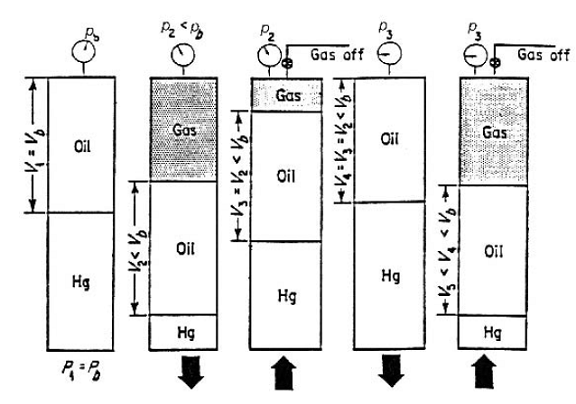Differential Liberation Test Assignment Help
Differential Liberation (Vaporization) Test
In the differential liberation process, the solution gas that is liberated from an oil sample during a decline in pressure is continuously removed from contact with the oil, and before establishing equilibrium with the liquid phase. This type of liberation is characterized by a varying composition of the total hydrocarbon system.
The experimental data obtained from the test include:

- Amount of gas in solution as a function of pressure
- The shrinkage in the oil volume as a function of pressure
- Properties of the evolved gas including the composition of the liberated gas, the gas compressibility factor, and the gas specific gravity
- Density of the remaining oil as a function of pressure
Differential Liberation Test Assignment Help By Online Tutoring and Guided Sessions at AssignmentHelp.Net

The differential liberation test is considered to better describe the separation process taking place in the reservoir and is also considered to simulate the flowing behavior of hydrocarbon systems at conditions above the critical gas saturation. As the saturation of the liberated gas reaches the critical gas saturation, the liberated gas begins to flow, leaving behind the oil that originally contained it. This is attributed to the fact that gases have, in general, higher mobility than oils. Consequently, this behavior follows the differential liberation sequence. The test is carried out on reservoir oil samples and involves charging a visual PVT cell with a liquid sample at the bubble-point pressure and at reservoir temperature. As shown schematically in above Figure, the pressure is reduced in steps, usually 10 to 15 pressure levels, and all the liberated gas is removed and its volume is measured at standard conditions. The volume of oil remaining VL is also measured at each pressure level. It should be noted that the remaining oil is subjected to continual compositional changes as it becomes progressively richer in the heavier components. The above procedure is continued to atmospheric pressure where the volume of the residual (remaining) oil is measured and converted to a volume at 60°F, Vsc. The differential oil formation volume factors Bod (commonly called the relative oil volume factors) at all the various pressure levels are calculated by dividing the recorded oil volumes VL by the volume of residual oil Vsc, or:

The differential solution gas-oil ratio Rsd is also calculated by dividing the volume of gas in solution by the residual oil volume. Relative total volume Btd from differential liberation as calculated from the following expression:
Btd = Bod + (Rsdb - Rsd) Bg
Where
Btd = relative total volume, bbl/STB
Bg = gas formation volume factor, bbl/scf
The gas deviation z-factor of the liberated (removed) solution gas at the specific pressure and these values are calculated from the recorded gas volume measurements as follows:

Where
V = volume of the liberated gas in the PVT cell at p and T
Vsc = volume of the removed gas at standard condition
Gas formation volume
It can be expressed by the following equation:

Where
Bg = gas formation volume factor, ft3/scf
T = temperature, °R
p = cell pressure, psia
Tsc = standard temperature, °R
psc = standard pressure, psia
It should be pointed out that the differential liberation test represents the behavior of the oil in the reservoir as the pressure declines. We must find a way of bringing this oil to the surface through separators and into the stock tank. This process is a flash or separator process.
Email Based Assignment Help in Differential Liberation Test
To submit Differential Liberation Test assignment click here.
Following are some of the topics in General Composition Of Petroleum in which we provide help:
- General Composition Of Petroleum
- Physical Properties Of Hydrocarbons
- Origin of Petroleum
- Fundamental properties Of Fluid Permeated Rocks
- Porosity
- Permeability
- The Klinkenberg Effect
- Saturation
- Wettability
- Capillary Pressure
- Relative Permeability
- Drainage Process
- Three phase Relative Permeability
- Rock Compressibility
- Fundamentals Of Reservoir Fluid Behavior
- Classification Of Reservoir And Reservoir Fluids
- Gas Reservoirs
- Fundamentals Of Reservoir Fluid Flow
- Types Of Fluids
- Properties Of natural Gases
- Behavior Of Ideal Gases
- Behavior of Real Gases
- Compressibility Of Natural Gases
- Properties Of Crude Oil Systems
- Gas Solubility
- Determination And Application of Reservoir Fluid Properties
- Composition Of The Reservoir Fluid
- Differential Liberation Test
- Separator Tests
- Fluid Analysis Data On Gas
- Constant-Volume Depletion
- Oil Recovery mechanisms And The material Balance Equation
- Primary Recovery Mechanisms
- The Depletion Drive Mechanism
- Gas Cap Drive
- The Water Drive Mechanism
- Water Production
- The Gravity-Drainage-Drive Mechanism
- The Combination-Drive Mechanism
- The Material Balance Equation
- Change in Pore Volume Due to Initial Water and Rock Expansion
- Gas Reservoirs Help
- The Volumetric Method
- The material Balance Method


